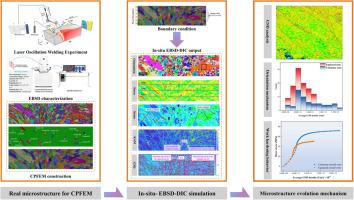In-situ EBSD-DIC simulation of microstructure evolution of aluminum alloy welds
IF 7.1
1区 工程技术
Q1 ENGINEERING, MECHANICAL
International Journal of Mechanical Sciences
Pub Date : 2024-09-23
DOI:10.1016/j.ijmecsci.2024.109741
引用次数: 0
Abstract
A comprehensive understanding of the dynamic evolution of weld microstructure under external loads can provide key insights for high-performance laser welding. A novel in-situ EBSD-DIC simulation method is introduced to study the microstructure evolution of laser welded aluminum alloys under uniaxial tensile action. An advanced crystal plastic finite element model (CPFEM) is developed, which combines the real microstructure, grain orientation and grain size effects. The results show that the dislocation density in columnar grain zone is higher than that in equiaxed grain zone. The continuous accumulation of dislocations in the columnar region results in a high work-hardening rate. This high work hardening rate enhances the plastic deformation capacity of the columnar crystal region, resulting in local strain concentration. Columnar zones are more prone to fracture because the high-strain region is a potential fracture site. In addition, low Angle grain boundary (LAGBs) is one of the reasons that the dislocation density of the columnar grain zone is higher than that of equiaxed grain zone during tensile process, which is conducive to dislocation slip of columnar grains. This study is a fundamental innovation in simulating the microstructure evolution of laser welding. This marks a major breakthrough in simulating the evolution of crystallographic features such as grain orientation, microstress and strain and dislocation density under external loads. This work can further provide practical guidance for “microstructure characteristics - mechanical property regulation”.

铝合金焊缝微观结构演变的原位 EBSD-DIC 模拟
全面了解外部载荷作用下焊缝微观结构的动态演化,可为高性能激光焊接提供重要见解。本文介绍了一种新颖的原位 EBSD-DIC 模拟方法,用于研究单轴拉伸作用下激光焊接铝合金的微观结构演变。建立了一个先进的晶塑有限元模型(CPFEM),该模型结合了真实的微观结构、晶粒取向和晶粒尺寸效应。结果表明,柱状晶粒区的位错密度高于等轴晶粒区。柱状晶粒区位错的不断积累导致了高加工硬化率。这种高加工硬化率增强了柱状晶区的塑性变形能力,导致局部应变集中。柱状区更容易断裂,因为高应变区是潜在的断裂部位。此外,低角度晶界(LAGBs)是拉伸过程中柱状晶区位错密度高于等轴晶区的原因之一,有利于柱状晶的位错滑移。这项研究是模拟激光焊接微观结构演变的一项根本性创新。这标志着在模拟外部载荷作用下晶粒取向、微应力和应变以及位错密度等晶体学特征的演变方面取得了重大突破。这项工作可进一步为 "微观结构特征--机械性能调节 "提供实际指导。
本文章由计算机程序翻译,如有差异,请以英文原文为准。
求助全文
约1分钟内获得全文
求助全文
来源期刊

International Journal of Mechanical Sciences
工程技术-工程:机械
CiteScore
12.80
自引率
17.80%
发文量
769
审稿时长
19 days
期刊介绍:
The International Journal of Mechanical Sciences (IJMS) serves as a global platform for the publication and dissemination of original research that contributes to a deeper scientific understanding of the fundamental disciplines within mechanical, civil, and material engineering.
The primary focus of IJMS is to showcase innovative and ground-breaking work that utilizes analytical and computational modeling techniques, such as Finite Element Method (FEM), Boundary Element Method (BEM), and mesh-free methods, among others. These modeling methods are applied to diverse fields including rigid-body mechanics (e.g., dynamics, vibration, stability), structural mechanics, metal forming, advanced materials (e.g., metals, composites, cellular, smart) behavior and applications, impact mechanics, strain localization, and other nonlinear effects (e.g., large deflections, plasticity, fracture).
Additionally, IJMS covers the realms of fluid mechanics (both external and internal flows), tribology, thermodynamics, and materials processing. These subjects collectively form the core of the journal's content.
In summary, IJMS provides a prestigious platform for researchers to present their original contributions, shedding light on analytical and computational modeling methods in various areas of mechanical engineering, as well as exploring the behavior and application of advanced materials, fluid mechanics, thermodynamics, and materials processing.
 求助内容:
求助内容: 应助结果提醒方式:
应助结果提醒方式:


